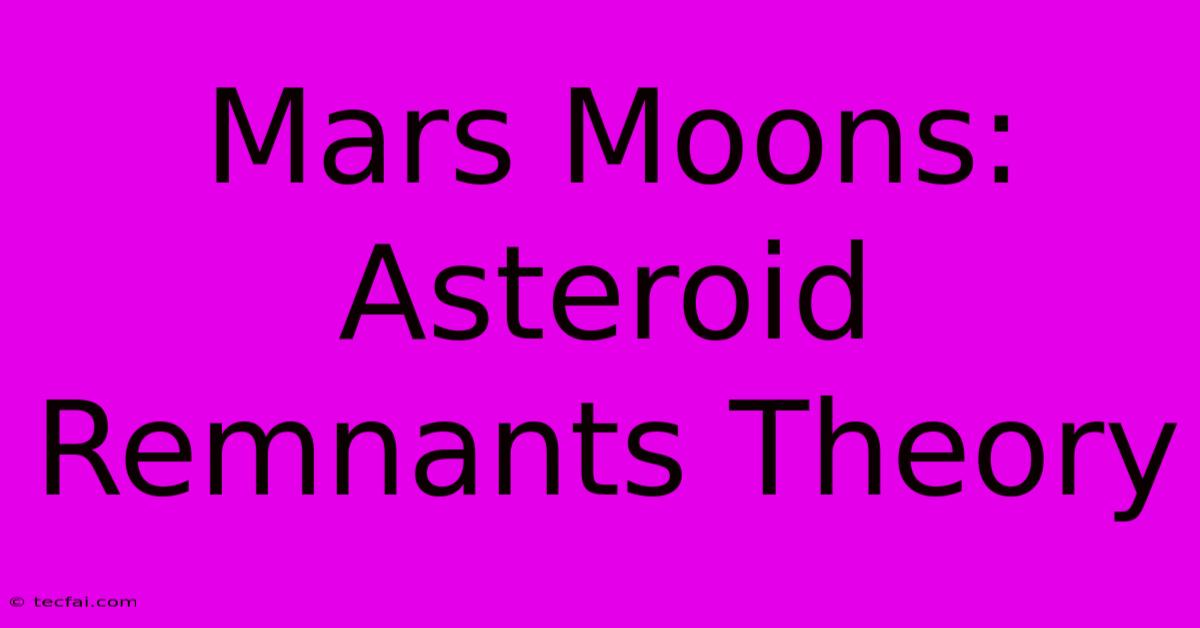Mars Moons: Asteroid Remnants Theory

Discover more detailed and exciting information on our website. Click the link below to start your adventure: Visit Best Website tecfai.com. Don't miss out!
Table of Contents
Mars Moons: The Compelling Asteroid Capture Theory
Mars, the rusty red planet, boasts two intriguing moons: Phobos and Deimos. While seemingly small and unremarkable compared to Earth's moon, these celestial bodies hold significant scientific interest, particularly concerning their origins. The leading theory suggests that Phobos and Deimos are not formed in situ alongside Mars, but rather are captured asteroids. This article delves into the evidence supporting the asteroid capture theory, examining the moons' characteristics and how they align with this compelling hypothesis.
The Case for Captured Asteroids: Evidence from Phobos and Deimos
Several key observations point towards the asteroid capture theory:
-
Composition and Density: Both Phobos and Deimos possess remarkably low densities and compositions similar to carbonaceous chondrites, a type of asteroid common in the outer asteroid belt. This compositional similarity strongly suggests an extra-planetary origin, differing significantly from the expected composition of materials that formed alongside Mars. Their porous nature further supports this, indicating they aren't monolithic bodies formed from the same materials as the planet itself.
-
Orbits: Their orbits are also highly suggestive. Phobos maintains a relatively close and nearly circular orbit around Mars, completing a revolution in just 7.6 hours. This proximity, coupled with its orbital decay (Phobos is slowly spiraling towards Mars), is unusual for a moon formed alongside its planet. Deimos, while further away, also possesses an orbit that's less eccentric than expected for a body gravitationally bound to Mars since its formation. These unusual orbital characteristics suggest a capture event where the gravitational pull of Mars overcame the asteroid's inertia.
-
Shape and Surface Features: The irregular shapes of Phobos and Deimos further solidify the argument. Unlike Earth's relatively spherical moon, these Martian moons are lumpy and asymmetrical, characteristics more aligned with the irregular shapes commonly observed in asteroids than moons formed from accretion disks. Their cratered surfaces also reflect a history of impacts, consistent with the harsh conditions prevalent in the asteroid belt.
-
Orbital Simulations: Numerous computer simulations have demonstrated that the capture of asteroids by a planet like Mars is indeed possible. These models consider various factors, such as the initial velocity and trajectory of the asteroid, the gravitational forces exerted by both Mars and the Sun, and the potential role of gravitational perturbations from other celestial bodies. These simulations have successfully reproduced orbits similar to those of Phobos and Deimos, lending credence to the capture theory.
Alternative Theories and Their Limitations
While the asteroid capture hypothesis remains the leading explanation, alternative theories exist, albeit with less supporting evidence. These include:
-
Co-formation: This theory proposes that Phobos and Deimos formed simultaneously with Mars. However, this is less plausible given their compositional differences and unusual orbits.
-
Collisional Ejection: This suggests that the moons were ejected from Mars after a significant impact. However, this theory struggles to explain the moons' composition and their relatively low density.
Ongoing Research and Future Missions
The mysteries surrounding Phobos and Deimos continue to fuel ongoing research and future space missions. Missions designed to directly sample and analyze material from these moons are crucial to further strengthen or refute the current leading theory. A deeper understanding of their internal structure and composition will allow scientists to further refine our understanding of planetary formation and the evolution of the Martian system.
Conclusion: A Strong Case for Captured Asteroids
The evidence strongly suggests that the Martian moons, Phobos and Deimos, are captured asteroids. Their composition, orbits, and shapes align remarkably well with this theory, while alternative hypotheses face significant challenges. Continued research and future exploration will undoubtedly unveil further insights into these fascinating celestial bodies and solidify our understanding of their origins. The study of Phobos and Deimos provides a valuable window into the dynamic processes that shaped the early solar system, offering clues to the distribution and evolution of asteroids and the formation of planetary systems.

Thank you for visiting our website wich cover about Mars Moons: Asteroid Remnants Theory. We hope the information provided has been useful to you. Feel free to contact us if you have any questions or need further assistance. See you next time and dont miss to bookmark.
Featured Posts
-
Jakes Suffers Health Issue During Service
Nov 26, 2024
-
Geldof On Band Aid Addresses Ed
Nov 26, 2024
-
T D Jakes Health Positive Progress
Nov 26, 2024
-
Predict Bayern Vs Psg Best Betting Tips
Nov 26, 2024
-
2025 Uk Bank Holiday Dates New Day Off
Nov 26, 2024
